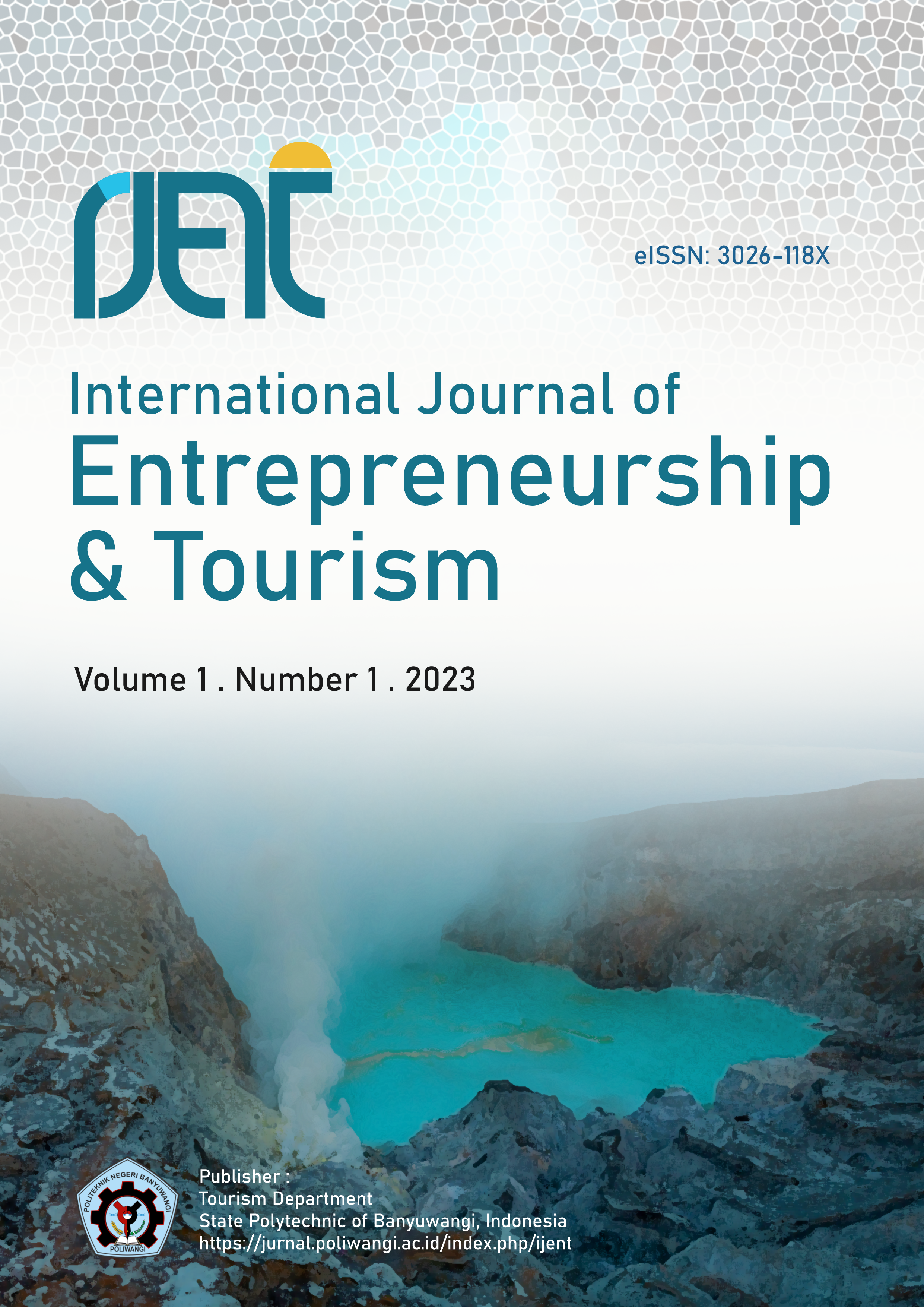A Struggling Phase Of A Tourism Village: A Case Study On Kemiri Tourism Village Jember
DOI:
https://doi.org/10.57203/ijent.v1i1.2023.1%20-%2010Keywords:
Kemiri Tourism Village, Tourism Village, 4 As Tourism ComponentsAbstract
Since its opening on March 2021, Kemiri Tourism Village was, still, facing a number of problematic issues. The decreasing number of visitors was an alarming sign for the destination. Investigating the current condition of the tourism village was essential to get a comprehensive picture of what really happened. Based on that purpose, this case study was conducted by utilizing the concept of 4 As tourism components covering attraction, accessibility, amenities, and ancillary. The data was collected through interview with Kelompok Sadar Wisata (Pokdarwis), tourism awareness group, of Kemiri, observation to the destination, and content analysis on visitors’ reviews and other accessible sources regarding the tourism village. The results of the data analysis showed that the tourism village faced a number of issues based on the 4 As tourism components. Regarding the attraction, the tourism village needed to discover its unique attractiveness to make the destination distinctive from other tourism villages. In addition, when dealing with amenities, Kemiri Tourism Village should make a big effort to rebuild the destination due to the fact that there were a number of facilities that did not exist any longer when compared to its initial condition. Widening and strengthening partnerships were also essential to achieve better networking that would be beneficial to improve promotions.
References
Andrianto, T., & Sugiama, G. (2016). The Analysis of Potential 4A’s Tourism Component in the Selasari Rural Tourism,Pangandaran, West Java. April 2020. https://doi.org/10.2991/atf-16.2016.21
Ary, D., Jacobs, L. C., Sorensen, C., & Razavieh, A. (2010). Introduction to Research in Education (8th ed.). Wadsworth.
Asmoro, B. T., Anwartinna, M., & Handayani, S. (2019). TOURISM AWARENESS GROUPS (POKDARWIS) INSTITUTIONAL CAPACITY DEVELOPMENT IN MANAGING COBAN PANDAWA TOURIST ATTRACTION. Prosiding ICOGISS 2019: International Confrence On Governance Innovation And Social Sciences, 146–156. https://doi.org/10.32528/pi.v0i0.2474
Bagaihing, M., Flora, V. A. S. M., & Lasibey, A. A. (2021). Analysis of 4 Tourism Components in Tirosa Park as a New Alternative Tourism in Kupang City. 544, 287–290. https://doi.org/https://doi.org/10.2991/assehr.k.210424.055
Benedetto, G. (2023). Enabling a sustainable rural-tourism: The challenge of accessibility. BIO Web of Conferences, 56, 03014. https://doi.org/10.1051/bioconf/20235603014
Fasa, A. W. H., Berliandaldo, M., & Prasetio, A. (2022). SUSTAINABLE TOURISM VILLAGES DEVELOPMENT STRATEGY IN INDONESIA: PESTEL ANALYSIS APPROACH. Kajian, 27(1), 71–87. https://doi.org/10.22212/kajian.v27i1.3612
Fletcher, J., Fyall, A., Gilbert, D., & Wanhill, S. (2018). Tourism : Principles and Practice Sixth Edition (Sixth). Pearson Education.
Ismail, T., & Rohman, F. (2019). The Role of Attraction, Accessibility, Amenities, and Ancillary on Visitor Satisfaction and Visitor Attitudinal Loyalty of Gili Ketapang Beach. Jurnal Manajemen Teori Dan Terapan, 12(2), 149–165.
Jejaring Desa Wisata. (2023). Peta Sebaran Desa Wisata. https://jadesta.kemenparekraf.go.id/peta
Kamal, M., Taufan, G., & Suharsono, D. (2023). Coastal Tourism in Southeast Jember: Key Challenges and Opportunities in the Development of Bandealit Beach. Proceedings of the 3rd International Conference on Social Science, Humanity and Public Health, ICoSHIP 2022, 05-06 November 2022, Banyuwangi, East Java, Indonesia. https://doi.org/10.4108/eai.5-11-2022.2326526
Kholifah, E., & Nusanto, B. (2022). Pelatihan Pembuatan Peraturan Desa Wisata di Desa Kemiri Kabupaten Jember. Journal of Community Development, 3(2), 199–210. https://doi.org/10.47134/comdev.v3i2.101
Lailatufa, I., Widodo, J., & Zulianto, M. (2019). STRATEGI PENGEMBANGAN OBJEK WISATA RUMAH APUNG BANGSRING UNDERWATER DI KECAMATAN WONGSOREJO KABUPATEN BANYUWANGI. JURNAL PENDIDIKAN EKONOMI: Jurnal Ilmiah Ilmu Pendidikan, Ilmu Ekonomi Dan Ilmu Sosial, 13(1), 15–19. https://doi.org/10.19184/jpe.v13i1.10412
Marija, D., Zubović, J., & Domazet, I. (2008). Human Resource Management – Developing Force of Tourist Industry. In CHALLENGES OF ECONOMIC SCIENCES IN THE 21st 410 CENTURY (Issue 159004, pp. 409–416).
Mun’im, A. (2022). Improvement on the Measurement of Tourism Contribution : An Alternative to Accelerating Indonesia ’ s Economic Growth. Jurnal Kepariwisataan Indonesia, 16(1), 1–14.
Pemerintah Daerah Kabupaten Jember. (2021). Kembali Bangkit, Desa Wisata Kemiri Dan Jember Coffee Centre (JCC) Akhirnya Diresmikan (Rising Back, Kemiri Tourism Village and Jember Coffee Center (JCC) Finally Inaugurated). https://www.jemberkab.go.id/kembali-bangkit-desa-wisata-kemiri-dan-jember-coffee-centre-jcc-akhirnya-diresmikan/
Silalahi, A. T., & Asy’ari, R. (2022). Desa Wisata Kemiren: Menemukenali dari Perspektif Indikator Desa Wisata dan Pariwisata Berbasis Masyarakat. TOBA: Journal of Tourism, Hospitality and Destination, 1(1), 14–24. https://doi.org/10.55123/toba.v1i1.104
Siwek, M., Kolasińska, A., Wrześniewski, K., & Zmuda Palka, M. (2022). Services and Amenities Offered by City Hotels within Family Tourism as One of the Factors Guaranteeing Satisfactory Leisure Time. International Journal of Environmental Research and Public Health, 19(14), 8321. https://doi.org/10.3390/ijerph19148321
Sudibya, B. (2018). Wisata Desa dan Desa Wisata. Bali Membangun Bali Jurnal Bapedda Litbang, 1(1), 21–24. https://doi.org/https://doi.org/10.51172/jbmb.v1i1.8.
Sugiama, A. G., Oktavia, H. C., & Karlina, M. (2022). The Effect of Tourism Infrastructure Asset Quality on Tourist Satisfaction: A Case on Forest Tourism in Tasikmalaya Regency. International Journal of Applied Sciences in Tourism and Events, 6(1), 65–71. https://doi.org/10.31940/ijaste.v6i1.65-71
The Ministry of Tourism and Creative Economy. (2020). Studi Mengenai COVID-19, Pariwisata dan Ekonomi Kreatif (Study on COVID-19, Tourism and Creative Economy). In Kementerian Pariwisata dan Ekonomi Kreatif. Ministry of Tourism and Creative Economy. https://bankdata.kemenparekraf.go.id/upload/document_satker/a6d2d69c8056a29657be2b5ac3107797.pdf
The Ministry of Tourism and Creative Economy. (2023). 4 Pilar Penting dalam Pemasaran Desa Wisata di Indonesia. https://kemenparekraf.go.id/hasil-pencarian/4-pilar-penting-dalam-pemasaran-desa-wisata-di-indonesia
Tsani, M. K., Harianto, S. P., Santoso, T., Masruri, N. W., & Winarno, G. D. (2021). Penilaian Wisatawan Terhadap Komponen Destinasi Wisata: Atraksi, Amenitas, Aksesibilitas dan Pelayanan Tambahan Pada Objek Wisata Kebun Raya Liwa. Jurnal Ilmu Kehutanan, 15(1), 13–27. https://doi.org/10.22146/jik.v15i1.1515
Wardani, P. A., Rahmanita, M., Farhan, M., & Pramudita, R. F. (2023). Community Participation in Tourism Destination Development: Lesson from Kelor Tourism Village. Journal of Language, Communication, and Tourism, 1(2), 1–9. https://doi.org/10.25047/jlct.v1i2.3987
Wijaya, N. S., & Sudarmawan, I. W. E. (2019). COMMUNITY BASED TOURISM ( CBT ) SEBAGAI STRATEGI PENGEMBANGAN PARIWISATA PEKRAMAN TEGALLALANG COMMUNITY BASED TOURISM ( CBT ) AS A SUSTAINABLE TOURISM DEVELOPMENT STRATEGY IN CEKING DTW , TEGALLANTANG. Jurnal Ilmiah Hospitality Management, 10(1), 77–98. https://doi.org/https://doi.org/10.22334/jihm.v10i1





